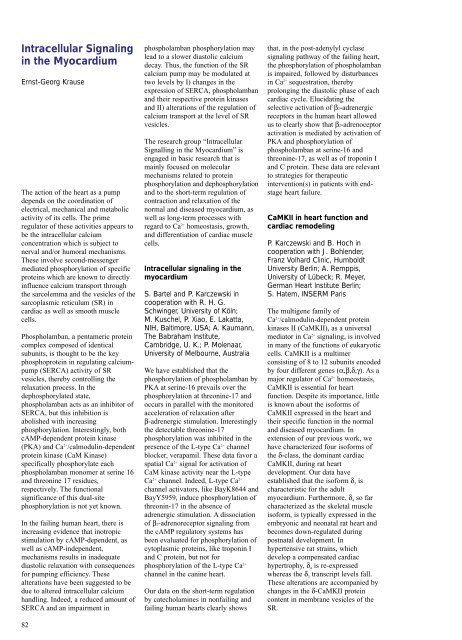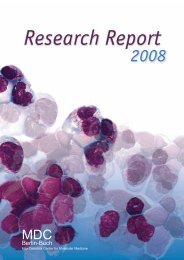Create successful ePaper yourself
Turn your PDF publications into a flip-book with our unique Google optimized e-Paper software.
Intracellular Signaling<br />
in the Myocardium<br />
Ernst-Georg Krause<br />
The action of the heart as a pump<br />
depends on the coordination of<br />
electrical, mechanical and metabolic<br />
activity of its cells. The prime<br />
regulator of these activities appears to<br />
be the intracellular calcium<br />
concentration which is subject to<br />
nerval and/or humoral mechanisms.<br />
These involve second-messenger<br />
mediated phosphorylation of specific<br />
proteins which are known to directly<br />
influence calcium transport through<br />
the sarcolemma and the vesicles of the<br />
sarcoplasmic reticulum (SR) in<br />
cardiac as well as smooth muscle<br />
cells.<br />
Phospholamban, a pentameric protein<br />
complex composed of identical<br />
subunits, is thought to be the key<br />
phosphoprotein in regulating calciumpump<br />
(SERCA) activity of SR<br />
vesicles, thereby controlling the<br />
relaxation process. In the<br />
dephosphorylated state,<br />
phospholamban acts as an inhibitor of<br />
SERCA, but this inhibition is<br />
abolished with increasing<br />
phosphorylation. Interestingly, both<br />
cAMP-dependent protein kinase<br />
(PKA) and Ca 2+ /calmodulin-dependent<br />
protein kinase (CaM Kinase)<br />
specifically phosphorylate each<br />
phospholamban monomer at serine 16<br />
and threonine 17 residues,<br />
respectively. The functional<br />
significance of this dual-site<br />
phosphorylation is not yet known.<br />
In the failing human heart, there is<br />
increasing evidence that inotropic<br />
stimulation by cAMP-dependent, as<br />
well as cAMP-independent,<br />
mechanisms results in inadequate<br />
diastolic relaxation with consequences<br />
for pumping efficiency. These<br />
alterations have been suggested to be<br />
due to altered intracellular calcium<br />
handling. Indeed, a reduced amount of<br />
SERCA and an impairment in<br />
82<br />
phospholamban phosphorylation may<br />
lead to a slower diastolic calcium<br />
decay. Thus, the function of the SR<br />
calcium pump may be modulated at<br />
two levels by I) changes in the<br />
expression of SERCA, phospholamban<br />
and their respective protein kinases<br />
and II) alterations of the regulation of<br />
calcium transport at the level of SR<br />
vesicles.<br />
The research group “Intracellular<br />
Signalling in the Myocardium” is<br />
engaged in basic research that is<br />
mainly focused on molecular<br />
mechanisms related to protein<br />
phosphorylation and dephosphorylation<br />
and to the short-term regulation of<br />
contraction and relaxation of the<br />
normal and diseased myocardium, as<br />
well as long-term processes with<br />
regard to Ca 2+ homeostasis, growth,<br />
and differentiation of cardiac muscle<br />
cells.<br />
Intracellular signaling in the<br />
myocardium<br />
S. Bartel and P. Karczewski in<br />
cooperation with R. H. G.<br />
Schwinger, University of Köln;<br />
M. Kuschel, P. Xiao, E. Lakatta,<br />
NIH, Baltimore, USA; A. Kaumann,<br />
The Babraham Institute,<br />
Cambridge, U. K.; P. Molenaar,<br />
University of Melbourne, Australia<br />
We have established that the<br />
phosphorylation of phospholamban by<br />
PKA at serine-16 prevails over the<br />
phosphorylation at threonine-17 and<br />
occurs in parallel with the monitored<br />
acceleration of relaxation after<br />
β-adrenergic stimulation. Interestingly<br />
the detectable threonine-17<br />
phosphorylation was inhibited in the<br />
presence of the L-type Ca 2+ channel<br />
blocker, verapamil. These data favor a<br />
spatial Ca 2+ signal for activation of<br />
CaM kinase activity near the L-type<br />
Ca 2+ channel. Indeed, L-type Ca 2+<br />
channel activators, like BayK8644 and<br />
BayY5959, induce phosphorylation of<br />
threonin-17 in the absence of<br />
adrenergic stimulation. A dissociation<br />
of β2-adrenoreceptor signaling from<br />
the cAMP regulatory systems has<br />
been evaluated for phosphorylation of<br />
cytoplasmic proteins, like troponin I<br />
and C protein, but not for<br />
phosphorylation of the L-type Ca 2+<br />
channel in the canine heart.<br />
Our data on the short-term regulation<br />
by catecholamines in nonfailing and<br />
failing human hearts clearly shows<br />
that, in the post-adenylyl cyclase<br />
signaling pathway of the failing heart,<br />
the phosphorylation of phospholamban<br />
is impaired, followed by disturbances<br />
in Ca 2+ sequestration, thereby<br />
prolonging the diastolic phase of each<br />
cardiac cycle. Elucidating the<br />
selective activation of β2-adrenergic<br />
receptors in the human heart allowed<br />
us to clearly show that β2-adrenoceptor<br />
activation is mediated by activation of<br />
PKA and phosphorylation of<br />
phospholamban at serine-16 and<br />
threonine-17, as well as of troponin I<br />
and C protein. These data are relevant<br />
to strategies for therapeutic<br />
intervention(s) in patients with endstage<br />
heart failure.<br />
CaMKII in heart function and<br />
cardiac remodeling<br />
P. Karczewski and B. Hoch in<br />
cooperation with J. Bohlender,<br />
Franz Volhard Clinic, Humboldt<br />
University Berlin; A. Remppis,<br />
University of Lübeck; R. Meyer,<br />
German Heart Institute Berlin;<br />
S. Hatem, INSERM Paris<br />
The multigene family of<br />
Ca 2+ /calmodulin-dependent protein<br />
kinases II (CaMKII), as a universal<br />
mediator in Ca 2+ signaling, is involved<br />
in many of the functions of eukaryotic<br />
cells. CaMKII is a multimer<br />
consisting of 8 to 12 subunits encoded<br />
by four different genes (α,β,δ,γ). As a<br />
major regulator of Ca 2+ homeostasis,<br />
CaMKII is essential for heart<br />
function. Despite its importance, little<br />
is known about the isoforms of<br />
CaMKII expressed in the heart and<br />
their specific function in the normal<br />
and diseased myocardium. In<br />
extension of our previous work, we<br />
have characterized four isoforms of<br />
the δ-class, the dominant cardiac<br />
CaMKII, during rat heart<br />
development. Our data have<br />
established that the isoform δ 3 is<br />
characteristic for the adult<br />
myocardium. Furthermore, δ 4 so far<br />
characterized as the skeletal muscle<br />
isoform, is typically expressed in the<br />
embryonic and neonatal rat heart and<br />
becomes down-regulated during<br />
postnatal development. In<br />
hypertensive rat strains, which<br />
develop a compensated cardiac<br />
hypertrophy, δ 4 is re-expressed<br />
whereas the δ 3 transcript levels fall.<br />
These alterations are accompanied by<br />
changes in the δ-CaMKII protein<br />
content in membrane vesicles of the<br />
SR.

















